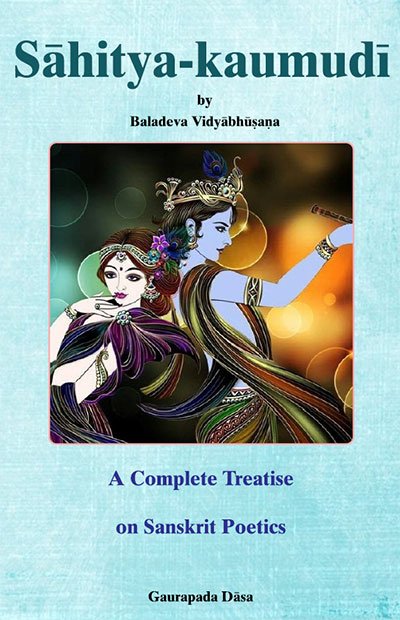Sahitya-kaumudi by Baladeva Vidyabhushana
by Gaurapada Dāsa | 2015 | 234,703 words
Baladeva Vidyabhusana’s Sahitya-kaumudi covers all aspects of poetical theory except the topic of dramaturgy. All the definitions of poetical concepts are taken from Mammata’s Kavya-prakasha, the most authoritative work on Sanskrit poetical rhetoric. Baladeva Vidyabhushana added the eleventh chapter, where he expounds additional ornaments from Visv...
Text 9.33
भेदाभावात् प्रकृत्य्-आदेर् भेदोऽपि नवमो मतः ॥ ९.८५ab ॥
bhedābhāvāt prakṛty-āder bhedo'pi navamo mataḥ || 9.85ab ||
bheda—of a variety; abhāvāt—because of the absence; prakṛti-ādeḥ—such as the word base; bhedaḥ—a variety; api—also; navamaḥ—ninth; mataḥ—is considered.
There is a ninth variety of śleṣa, since this one is not accounted for in the previous categories.
ihāpir bhinna-krame.
Here the term api (also) is out of sequence. (The words bhedo’pi navamaḥ should read: navamo’pi bhedaḥ.)
Commentary:
Mammaṭa did not group this śleṣa with the other ones because at first he followed the tradition by listing those eight varieties, seen throughout Daṇḍī’s Kāvyādarśa and categorized in that way by Rudraṭa,[1] and now he adds one variety of his own.
Mammaṭa’s śleṣa is a double meaning of sentences. Narahari Sarasvatī Tīrtha reasons that this kind of śleṣa was not automatically obtained before because the previous eight categories only related to compounds or to single words.[2] However, bhāṣā-śleṣa consists of a double meaning of a sentence and so on. The inconsistency is removed by considering that bhāṣā-śleṣa is a subcategory of Mammaṭa’s ninth śleṣa. Śrīvatsa-lāñchana Bhaṭṭācārya and Nāgeśa Bhaṭṭa explain that Mammaṭa’s śleṣa is a double meaning achieved by the tātparya (the drift, i.e. the sense derived from the syntactical connection of the words).[3]
Footnotes and references:
[1]:
varṇa-pada-liṅga-bhāṣā-prakṛti-pratyaya-vibhakti-vacanānām |
atrāyaṃ matimadbhir vidhīyamāno’ṣṭadhā bhavati || (Kāvyālaṅkāra 4.2)
[2]:
